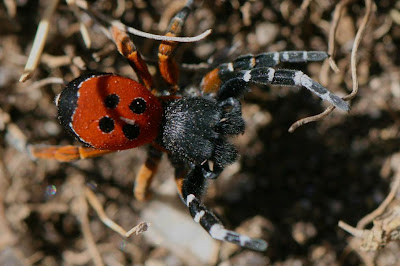
 As you can see is something like a miniature version of the big, hairy spiders, tropical, highlighting a well-developed chelicerae, which indicates that the immobilization of their prey does not depend on the spider but do a good grip and inject enough poison. The Eresus live in silk-lined tunnel about 10 cm deep, hidden among rocks and roots of plants. The inlet cone is poorly developed, not so much a fabric of capture as a warning that a dam passes by. Prey animals are often life on Earth as small beetles, spiders and other myriapods.
As you can see is something like a miniature version of the big, hairy spiders, tropical, highlighting a well-developed chelicerae, which indicates that the immobilization of their prey does not depend on the spider but do a good grip and inject enough poison. The Eresus live in silk-lined tunnel about 10 cm deep, hidden among rocks and roots of plants. The inlet cone is poorly developed, not so much a fabric of capture as a warning that a dam passes by. Prey animals are often life on Earth as small beetles, spiders and other myriapods. In late summer the males wander about looking for the nest of a female and when it most easily be found. No need to fear spiders as well as other partners because their great indeed, only go to live with them and share their food. It seems that once their reproductive duty may become eaten, although it is unclear who is not after death, because after playing in any event, usually death.
The female lays eggs in a silk-wrapped package and puts them out of the tunnel or under the weather so you always have the best conditions of temperature and humidity. When pups are born, live with his mother and thus pass autumn and winter all sharing the same nest. The mother may die of old in this period (at the age of four years) and then harvested for their offspring the food available in the same way she did with her husband. According
database Iberian fauna and the web of spiders Iberian Peninsula in the two species of the same genus E. and E. solitarius sedilloti. There are also references a species derived from North Africa: Eresus albopictus.
Another species of a genus of the same family, although not as colorful, is located in the southern half Peninsular: Stegodyphus lineatus. The family of the EREs, has some 100 species of African and Eurasian distribution. Edito
to add an appointment I had read but was unable to verify:
In his book "The Garden of the Gods", the third in the trilogy of Corfu Gerald Durrell delicious pages devoted to the species Eresus niger but I fear that in the Greek islands this is not the species present under current nomenclature.
0 comments:
Post a Comment